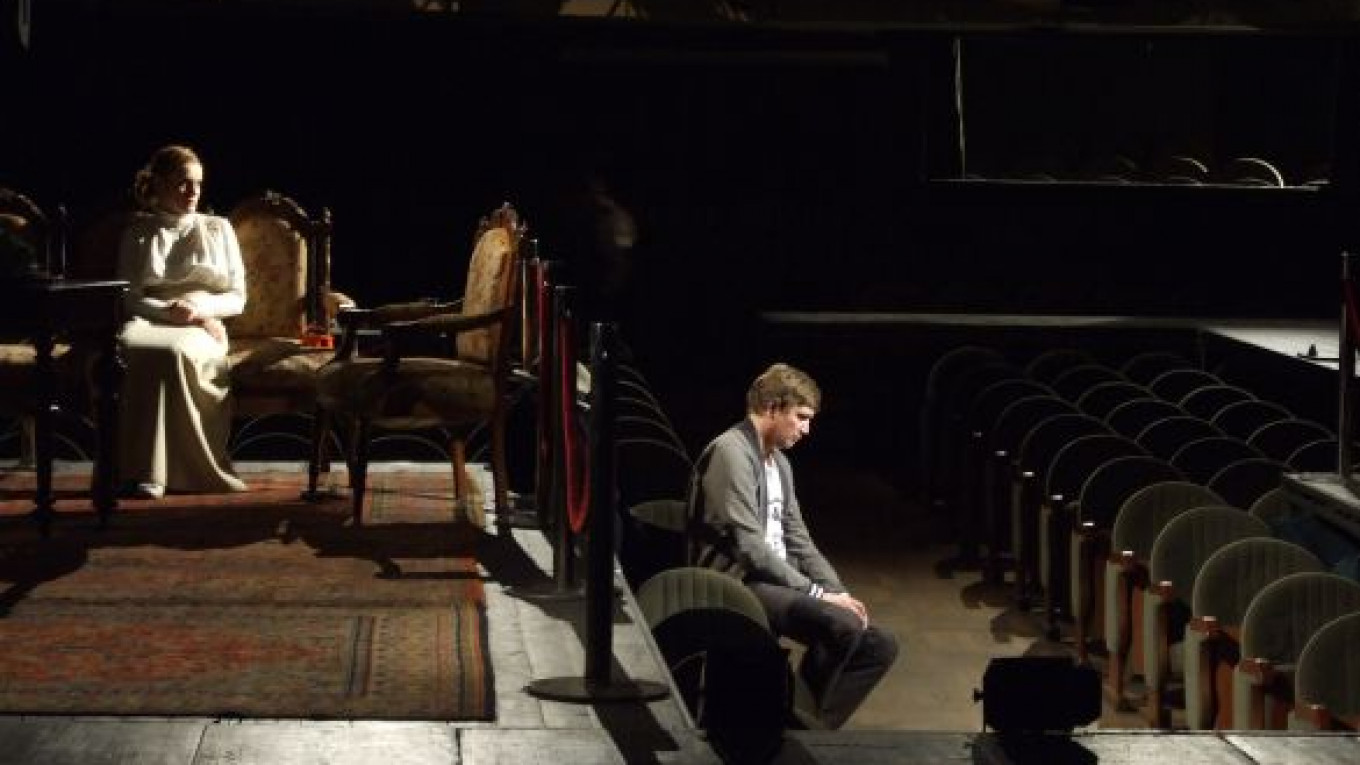Konstantin Stanislavsky, a 20th-century icon of world theater, has been something of a thorn in the side of progressive Russian theater artists of late.
Stanislavsky’s acting “system” involving theories and techniques for achieving psychologically accurate performances on stage has almost made him anathema to anyone searching for a contemporary aesthetic. Of course it’s not so much the system itself that artists find irritating, but rather the hyperbole and dogma that have accrued to him over eight or nine decades.
The fact of the matter is that few really know Stanislavsky and his work beyond the legends and cliches.
“I Don’t Believe,” a new play by Mikhail Durnenkov at the Stanislavsky Drama Theater, grabs the legend by the lapels and shakes it up.
Interestingly, this seems to be a recent policy at the Stanislavsky, where last summer Yelena Gremina’s play “The Brothers Ch.” debunked myths about Anton Chekhov and his family.
Under the guidance of artistic director Alexander Galibin, the theater is making an effort to reclaim and reinterpret important aspects of Russia’s cultural heritage.
“I Don’t Believe,” a phrase Stanislavsky supposedly spoke to his actors when they failed to rehearse convincingly, is directed here with vision and chutzpah by Marat Gatsalov. On one hand I would hazard to say Gatsalov created a chaotic performance that occasionally teeters on the cusp of impenetrability. But at the same time, he offers a compelling and challenging piece of theater that invariably kept me chasing after all of its loose ends.
Durnenkov’s highly populated and fragmentary play drew its inspiration from Stanislavsky’s autobiography, “My Life in Art.” It depicts a moderately misunderstood man named Konstantin struggling to become an actor and director as he performs in a play about a man named Alexeyev, who took on the pseudonym of Stanislavsky.
Judging by the attitudes of parents, lovers, friends and colleagues, this Stanislavsky’s talents are not apparent to all. What no one can deny, however, is his passion and commitment to his dream.
Designer Ksenia Peretrukhina located Gatsalov’s production in a copy of one of those apartment museums that are so familiar in Russia. She undermined anyone’s hopes of perceiving this as a “realistic” setting, however, by building the performance space on two platforms that are laid out over top of the theater’s rows of seats. The audience sits on a grandstand located on the stage and looks back out into the theater’s orchestra and balcony.
As Stanislavsky, Alexander Userdin is clumsy and hardheaded. He is also rather nondescript, especially early on. It is as if those who doubt he has the talent to become anything are probably right.
But sheer commitment to do what he has set out to do is what brings this Stanislavsky and this production to a moment of truth.
As the troupe prepares to perform a new play, they stand with the spectators on stage before a closed curtain. Nerves are taut. One man’s suggestion that they cancel to avoid disaster brings a tirade from Stanislavsky that is performed by the actor, directed by Gatsalov and written by Durnenkov in such a way that it is impossible to perceive as anything but these specific artists’ own declaration of commitment to their profession.
The gist of it is that it’s either art or death.
When an actor barks out that he is ready to go, Stanislavsky snaps angrily, “I don’t believe it!” thus subverting and renewing that famous phrase.
The moments of Stanislavsky’s troupe before the curtain pull the episodes of Durnenkov’s play together. Each actor stands in a long row stretching the width of the stage and plays a kind of homemade percussive instrument. Music, like theater, can only happen when each part is played in some degree of harmony with others.
There is a tangible sense here of the creative chaos, the courage, the impudence, the madness, the stubbornness and the element of chance that go into the making of any theatrical performance.
What do we really see at the end of “I Don’t Believe”?
Is it an interpretation of what some historical figures may have experienced, or is it a ritual confession of the actual performers who stand before us?
I would argue it is the latter, and that at this instant Gatsalov and his company leave behind Stanislavsky or any play about him. I find it hard to imagine a better way of reinvesting the myth of Stanislavsky with new meaning.
“I Don’t Believe” (Ne Veryu) plays March 9 and 10 at 7 p.m. at the Stanislavsky Drama Theater, located at 23 Tverskaya Ulitsa. Metro Pushkinskaya. Tel. 699-7224. Running time: One hour 55 minutes.
A Message from The Moscow Times:
Dear readers,
We are facing unprecedented challenges. Russia's Prosecutor General's Office has designated The Moscow Times as an "undesirable" organization, criminalizing our work and putting our staff at risk of prosecution. This follows our earlier unjust labeling as a "foreign agent."
These actions are direct attempts to silence independent journalism in Russia. The authorities claim our work "discredits the decisions of the Russian leadership." We see things differently: we strive to provide accurate, unbiased reporting on Russia.
We, the journalists of The Moscow Times, refuse to be silenced. But to continue our work, we need your help.
Your support, no matter how small, makes a world of difference. If you can, please support us monthly starting from just $2. It's quick to set up, and every contribution makes a significant impact.
By supporting The Moscow Times, you're defending open, independent journalism in the face of repression. Thank you for standing with us.
Remind me later.







